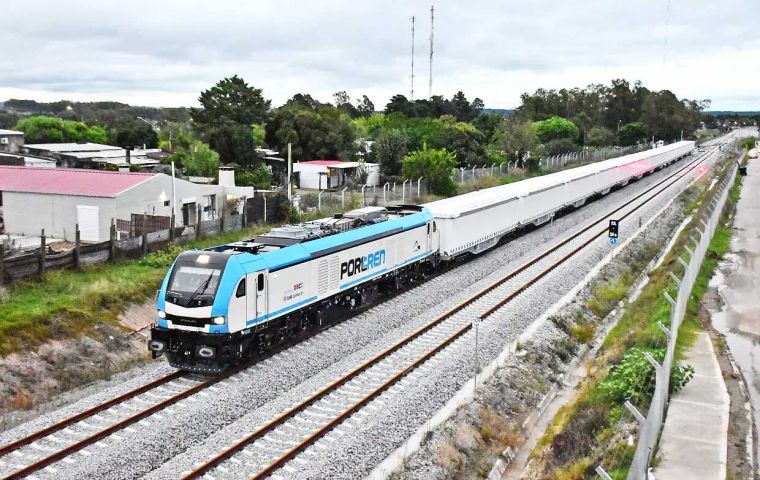MercoPress. South Atlantic News Agency
Uruguay's new cargo train completes first trip
 “UPM's people, of course, have a fundamental role in this first stage of the new railway development in Uruguay,” Falero admitted
“UPM's people, of course, have a fundamental role in this first stage of the new railway development in Uruguay,” Falero admitted Uruguay's first railway shipment between the UPM 2 pulp mills and the port of Montevideo arrived at its destination Tuesday at 6 pm after traveling 264 kilometers, marking the beginning of a new era. “It is not the UPM train, it is the railroad that will run in Uruguay,” Transport Minister José Luis Falero stressed.
The convoy is scheduled to feature 26 cars, but for its first test trip, it was equipped with half that many. The journey started on Monday and reached the Uruguayan capital after a stop in Juanicó. The train is expected to carry 4 million tons of pulp yearly from the UPM 2 mill to Montevideo.
“Uruguay has unique conditions for the region, especially in the logistics issue, and what multimodal transport means for the logistics of a country and the possibility of receiving goods from other countries and the conditions we have in the port of Montevideo, allow us to think that we have a huge potential for development in the short and medium term. And today an important step is being taken,” Falero argued.
He also admitted other logistics negotiations were going on involving the Central Railway, which “clearly shows us that it is not UPM's train, it is the railroad that will run in Uruguay that enables the transportation of UPM and other cargo that want to use it,” the minister explained while dubbing Tuesday's event as a “milestone.”
It is “a very important achievement for the country, an achievement that has been in the works for a long time,” he went on. “It began in the previous administration, we are continuing it.”
“There has been an involvement of everyone so that something transcendental can happen again in Uruguay,” Falero also noted. “Railway transport once again plays a fundamental role within a country's development policy.”
“UPM's people, of course, have a fundamental role in this first stage of the new railway development in Uruguay, which is to assume the commitment to transport its cellulose by rail, which will lead to the fact that this modern, new, state-of-the-art railway network will have already occupied 50% of the cargo capacity through UPM to the port of Montevideo since its beginning,” the official insisted.
Montevideo has an “excellent” port. “In a short time, we will have it at 14 meters and that will also allow us to give an important qualitative step forward in terms of the region's competitiveness in the world,” the official also pointed out about the recent agreement with Argentina to further dredge the River Plate to allow in some extra ship tonnage.
However, exports fell again by 14% year on year in March, according to Uruguay XXI's foreign trade report released Tuesday in Montevideo. Shipments worth US$ 893 million represented a significant decrease from 2023, although some areas -such as cellulose- showed a positive performance. Wheat and vehicles also went up while beef and rapeseed slid down.
The first quarter of 2024 closed with a 2% drop compared to the same period of the previous year, highlighting the negative evolution in the placements of beef, rapeseed, canola, and rice as relevant factors for this trend.
Cellulose continues to be the most exported product in 2024, reaching a total of US$ 157 million and showing a year-on-year increase of 9% despite a fall in prices compensated by a growth in volume.
Beef remained the second most exported product but showed a 27% decrease in March, mainly due to lower purchases from China while sales to the United States went up 37%.
Wheat showed a positive performance, with an impressive increase of 220% compared to the previous year, with placements to Angola and Brazil standing out. In addition, vehicle exports also showed a positive impact in March 2024, with significant increases in sales to Brazil and Argentina.
Uruguay XXI also underlined an improvement in the way the country was perceived by foreign companies as a possible destination for their investments given its favorable business climate.




Top Comments
Disclaimer & comment rulesCommenting for this story is now closed.
If you have a Facebook account, become a fan and comment on our Facebook Page!